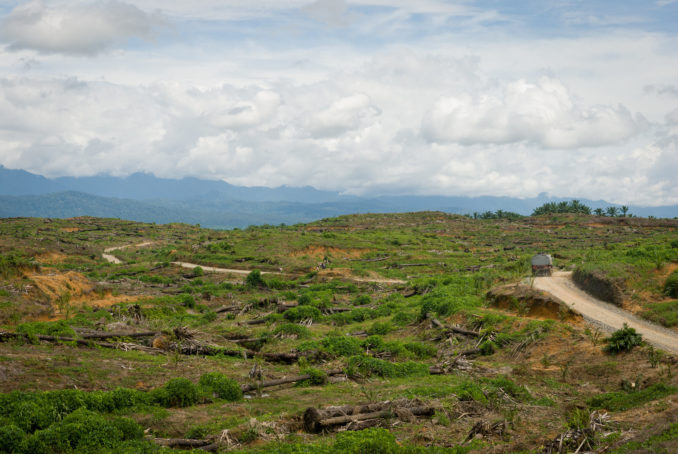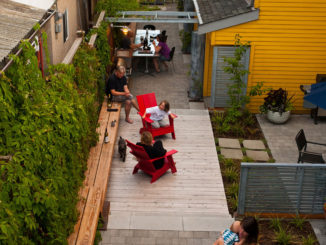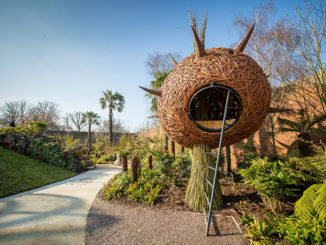
By Michael Grove, ASLA
Many of the articles I have read about how the design community should react to a post-pandemic world seem to be human-centric: advancing sensor technology to limit our need to touch door handles or elevator buttons; designing buildings to be flexible such that they can serve as temporary triage centers or hospitals; expanding our urban parks so city dwellers have more recreational opportunities post-quarantine because of our renewed appreciation of the outdoors. These are all great ideas, but they’re band-aids on a gaping wound. Until we stop disrupting ecosystems and thus reducing biodiversity, our efforts are superficial.
Instead, there are four fundamental areas that we should be focusing on, and which landscape architects have the unique skillset to lead. These include 1) championing habitat conservation; 2) fighting climate change; 3) advocating for responsible urbanization and limiting sprawl; and 4) supporting advanced agriculture. To be clear, I am not suggesting that landscape architects are going to prevent the emergence of new viruses. But if we, as a species, aim to limit our potential future exposure, landscape architects play a vital role.
1. Championing Habitat Conservation
Habitat destruction and biodiversity loss doesn’t only occur when we cut down tropical rainforests, though preserving rainforests is one of the most important ways to prevent future crossover viruses like COVID-19. Degraded habitats create ideal conditions for many different types of viruses to occur. COVID-19 is not the first disease to crossover from animal to human populations, but is likely a harbinger of more mass pandemics and further disruptions to the global economy. In fact, the World Health Organization notes that approximately 75% of emerging infectious diseases in humans are zoonotic, meaning that they are transmitted to us through contact with animals.
The initial emergence of many of these zoonotic diseases have been tracked to the parts of the world with the greatest biodiversity, both in the traditional and man-made sense. Traditional locations include tropical rainforests where biodiversity naturally occurs. Human-influenced conditions include places like bushmeat markets in Africa or the wet markets of Asia, where we are unnaturally mixing trapped exotic animals with humans, often in astonishingly unsanitary conditions. When we assault these wild places that harbor so much biodiversity, we are disregarding a significant aspect of this biodiversity—the unseen domain of undocumented viruses and pathogens. These microbes are not naturally human pathogens. They become human pathogens because we offer them that opportunity. Natural ecosystems are not what pose the threat—the human activity that disrupts these systems is the real culprit.
By teaming up with ecologists, conservation scientists, and citizen action groups, landscape architects have a pivotal role to play in promoting conservation as unequivocally the most important pillar of our profession, far above the artistry or craftsmanship that we promote in our professional photographs and design magazines.
2. Fighting Climate Change
Humanity’s purposeful destruction of the planet’s biodiversity is even more devastating to planetary balance in the era of rapid climate change. What were once stable ecosystems for millennia are transforming quicker than the species that live in them can adapt, leading to displacement and increased contact with humans. The impact is shockingly simple and linear. Droughts, floods, glacial melting, and forest fires each contribute to the accelerated displacement of millions of species. This shift leads to closer contacts between humans and wildlife, often inflicting trauma on the animal populations. Stressed animals, just like humans, become immunocompromised and thus more susceptible to disease, and more likely to shed higher viral loads. This increases the risk of spreading new diseases to the livestock or humans with which they come into contact.
The result is well-documented. Recent outbreaks of Ebola are linked to deforestation and encroaching human settlement throughout West Africa. The emergence of various avian influenzas have been traced to intensive chicken farming where crowded, unhygienic conditions elevated stress levels in the associated poultry population. Preliminary research into COVID-19 has led scientists to hypothesize that this latest coronavirus may have emerged from bats and pangolins due to a resemblance in its molecular structure to related viruses found in those species.
This risk of pathogens emerging due to climate change isn’t limited only to the tropics, or to unsanitary markets in developing countries. Recently, researchers announced the discovery of 28 previously unknown viruses entombed for 15,000 years within a melting glacier in Tibet. As the planet continues to warm, it is conceivable that even more pathogens like these could be released into the environment, with unpredictable consequences. Unfortunately, the image of an emaciated polar bear no longer tugs at our collective heartstrings. And why would it? Humans, just like any other species, are focused on our own survival first. Now is the time to shift the climate and environmental advocacy narrative from one of compassion to one of fear. You may not be able to imagine how your grandchildren’s lives will be impacted by a six-foot rise in sea levels, but when your own existence (and economic stability) is challenged by a deadly virus, you demand action—and fast. Humans are the ultimate umbrella species. If we can convince ourselves that saving the planet’s biodiversity will prevent the next outbreak, we may have a chance.
As a profession, landscape architecture has already demonstrated our value through resiliency plans to accommodate urban flooding and sea level rise. What comes next is a shift of our focus from protecting the built urban realm to a more holistic, reparative approach. For the sake of the survival of our own species, landscape architects must use our collective professional voice and commit to no longer working on greenfield sites, and instead focus on restoring our rural and peri-urban environments to pre-development conditions.
3. Advocating for Responsible Urbanization and Limiting Sprawl
One COVID-19 reaction that has been particularly alarming is the increasing traction of the anti-density movement. Headlines proclaiming how sprawl may save us and that living in cities puts citizens at higher risk for contracting the novel coronavirus are deceptive. Recent studies have debunked this myth, finding little correlation between population density in cities and rates of COVID-19, instead attributing the spread of the virus to overcrowding due to inequity and delays in governmental responsiveness. Mounting evidence suggests that COVID-19 is primarily transmitted through close contact in enclosed spaces. Internal population density within buildings and, more specifically, within shared rooms inside buildings is what drives this—not the compact urban form of the city. In New York, for example, COVID-19 cases are concentrated in the outer boroughs, and suburban Westchester and Rockland counties have reported nearly triple the rate per capita than those of Manhattan. The real issue is the systemic economic inequity which forces lower income people to live in overcrowded conditions, regardless of location. Cities are not at fault. Again, global sprawl into sensitive habitats is the problem. Cities, in fact, are the answer. The more densely we build, the more land we can conserve for nature to thrive and viruses to be contained.
Our response to the pandemic absolutely highlights the need for an overhaul of existing approaches to urban planning. Moving out of dense cities into the open space and social distancing afforded by the suburbs is exactly the type of knee-jerk reaction that we must avoid. The disruption of pristine forests due to logging, mining, urbanization, and population growth is bringing us closer to species with which we have rarely had contact. By infringing on their habitats, we are again reducing the natural barriers between humans and host species, creating ideal conditions for diseases to spread.
This is especially evident in the fragmented forests of our suburbs, where development patterns have altered the natural cycle of the pathogen that causes Lyme disease. When humans live in close proximity to these disrupted ecosystems, they are more likely to get bitten by a tick carrying the Lyme bacteria. When biodiversity is reduced, these diluted systems allow for species like rodents and bats—some of the most likely to promote the transmission of pathogens—to thrive. This essentially means that the more habitats we disturb, the more danger we are in by tapping into various virus reservoirs.
So what can landscape architects do? We can remember that our purpose is to be at the forefront of safeguarding public health. In the late 19th and early 20th century, cities benefited from engineering improvements to water supplies and sewerage. This set the foundation for luminaries like Frederick Law Olmsted to design some of our most beloved parks. By the mid-20th century, the environmental crisis documented by prominent thinkers like Ian McHarg further exposed societal inequities that still exist today. The luxuries of wealth and the cruelty of poverty are exacerbated in the current pandemic. The threat of disease remains greater in the most vulnerable corners of society. People hardest hit by COVID-19 are the urban poor, whose pre-existing conditions are a result of our complacency when it comes to issues of environmental justice and equitable access to nature.
It is incumbent upon us as landscape architects to petition government leaders to stop funneling money to signature projects in already wealthy neighborhoods, and instead ensure that new parks are built in underserved communities. By demanding equitable policies for public open space, we can leave a legacy that allows all citizens of our post-pandemic cities to thrive.
4. Supporting Advanced Agriculture
A logical question that arises from the argument for building denser cities and allowing the rest of the planet to revert to a mostly pre-development state is where our food will then come from. The answer is, we will have to double down on implementing innovative approaches to sourcing what we eat. Our current agricultural methods are unsustainable, damaging, and even negligent. On the whole, deforestation and habitat loss is primarily a result of the expansion of agriculture and overgrazing much more than from sprawling human settlement. Viruses linked to bats emerged because of the loss of traditional bat habitat due to farming. Nipah virus for example, which originated in Malaysia, was linked to an escalation of pig farming and fruit production. Fruit bats, displaced by drought-induced forest fires, began feeding on fruit trees grown on farms that also raised pigs. This new proximity enabled the virus to crossover from bats to pigs to humans.
Viruses like COVID-19 and other pathogens are also likely to jump from animals to people in the informal markets of developing nations where species ranging from birds to mammals to rodents are caged, sold, and slaughtered in densely populated areas with poor sanitation. Although changes to these centuries-old practices require a cultural shift and top-down policies to reduce their risks to society, now is the time for bold action. The era of unhygienic farming, slash-and-burn agriculture, and unregulated food sources must end now. New technologies like plant-based protein and new methodologies like vertical urban farming must be rapidly adopted.
As activists for the responsible use of natural resources, landscape architects must speak out against the ravages of corporate farms on the environment. We must advocate for community-based agriculture. We must integrate urban farming and productive landscapes into all of our projects to enhance food security. And we must continue to research, test, and aggressively campaign for revolutionary transformations to the way we source our food.
A Critical Path Forward
This is a pivotal moment for all landscape architects to put our skills to vital use. It is an opportunity to rewrite our manifesto and alter the course of the profession. For those who still don’t know what landscape architecture is, this is our chance to shed its cloak. Just as Frederick Law Olmsted shaped parks that responded to the health crisis of the time, Ian McHarg advocated for environmental action, and Hideo Sasaki opined about the opportunity to diverge from designing gardens for the 1%, we must define a new trajectory for the profession of landscape architecture. Now is the moment to put the health of the planet before any human desires, and to lead with our conviction that landscapes and ecology must drive the decision-making process—not for personal fame or fortune—but for the sake of our shared humanity, and of our very existence.
Michael Grove is the Chair of Landscape Architecture, Civil Engineering, and Ecology at Sasaki, a global design firm with offices in Boston and Shanghai.



